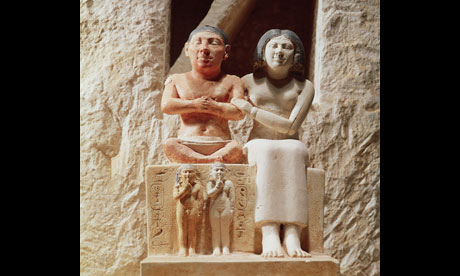 |
The Dwarf Seneb and his Family portrays the Ancient Egyptian official as a full and distinctive person. Photograph: Roger Wood/Corbis |
An Egyptian family sit proudly for the artist – I nearly wrote, for the camera. But the lifelike portrayal of the Dwarf Seneb and his Family, one of the most captivating things in the Egyptian Museum in Cairo, right at the heart of the revolution on Tahrir Square, was carved and painted at least 4,000 years before the invention of photography. It is one of the earliest works of art in history to which it seems fitting to give the title "portrait."
Of course, Seneb, his wife and their two children did not really "sit" or pose for their portraits. For one thing, this is a posthumous image of Seneb, made to fit into a niche in his tomb close to the Pyramids of Giza. But it achieves its moving sense of picturing real people, in all their uniqueness, by a bold utilisation of physical facts. Seneb was a dwarf, but smallness did not hold him back in life – as this fine work of art from his expensive tomb attests. The artist has deliberately used physical difference to proclaim Seneb's individuality; his two children stand in front of his short figure in place of adult-length legs. Meanwhile his tall, slender wife touches her husband affectionately. This is a loving family, memorialised for the ages.
Even to use the word "history" is to come up against the fact that Old Kingdom Egypt, from which these faces come to us, flourished when most places on Earth were firmly prehistoric. No faces as lifelike and graceful and humane as these survive from Britain or Europe 4,000 years ago. When Seneb was being portrayed as a full and distinctive person, the builders of Stonehenge were leaving wordless, silent, and remote monuments.
We look at the pyramids, and imagine them too as the monuments of a massively forbidding society. But look closer, and the culture that built these wonderful structures abounds in personality, character, and ordinary peoples' faces, bodies, voices. Seneb is not an anonymous functionary in an authoritarian order. He is gloriously himself. His family are so recognisable and loving. Perhaps this icon of the Egyptian Museum – the very museum that is seeing such dramatic scenes and historic moments again this week – is a reminder that the democratic sense of individuality and pluralism has deep and ancient and universal roots, not least in Egypt.
_________________
References:
Jones, Jonathan. 2011. "Could this be the earliest portrait in history?" Guardian. Posted: February 9, 2011. Available online: http://www.guardian.co.uk/artanddesign/jonathanjonesblog/2011/feb/09/egypt-portrait-seneb-family
No comments:
Post a Comment